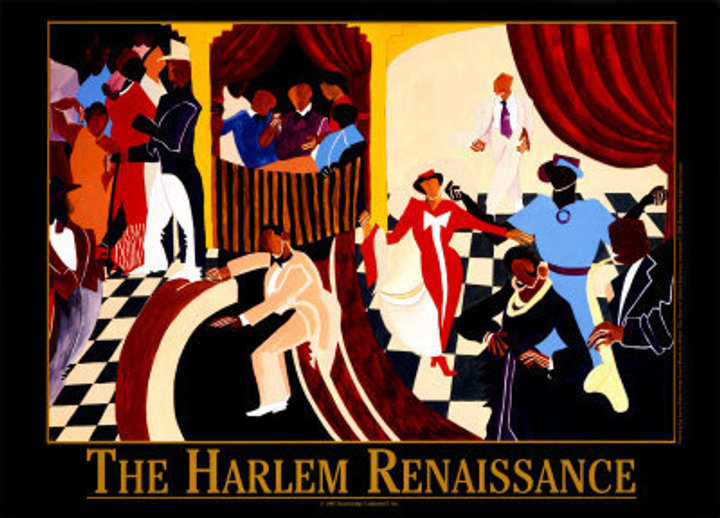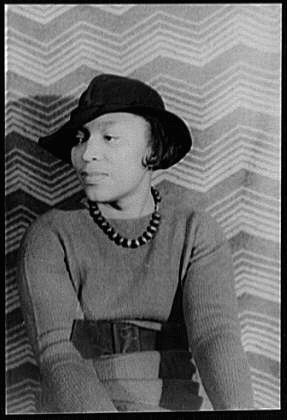Harlem RenaissanceFrom The Peopling of New York City: HarlemOur class attended the event "Harlem Serenade: A Moment in Time" at the Museum of Natural History, and this was a dedication to the golden age of the neighborhood. People who had lived in Harlem during that time talked about what it was like, and how Harlem had changed over time. What was the Harlem Renaissance? A time when a community was reborn, in cultural wealth and intellectual independence. The Harlem Renaissance was a rebirth of African American culture through music, poetry, and theatre. During the Great Migration of rural African Americans to urban areas such as New York City, Black culture grew as artists and musicians found a place for their creativity to flourish in communities like Harlem. One of the most influential writers during this period was Langston Hughes who lived in the neighborhood, and focused on the culture and importance of African Americans. African Americans challenged racism by creating art, which questioned how they could be considered as second class citizen while producing first class literary, musical, and artistic works. Harlem was trendy and hip during the roaring 20s, the highlight of Harlem Renaissance, and white audiences flocked to Harlem to be entertained in venues like the Cotton Club and the Apollo Theater. The main reason art and music in Harlem boomed so tremendously was not because prior to the Harlem Renaissance art did not exist, but rather because it had not been popularized and sponsored.
EducationDespite schools in Harlem being open to Black and white students on a non-segregation basis, a number of schools maintained an all Black population, primarily because of the increase of Black residents in Harlem. As the number of African Americans took advantage of free public education, schools quickly became overcrowded. Some principals did not welcome African Americans to their schools and students often became victims of racial slurs by teachers and students. School buildings were often dilapidated structures and many of them did not have playgrounds for their students. Further the economic condition of the new arrivals forced many students to work long hours before and after school. Thus, delinquency was common. There emerged discussions of the kind of education most beneficial to meet the needs of African Americans. The philosophical controversy that engaged educational thought was the teachings of Booker T. Washington’s doctrine of education for African Americans and the educational philosophy for African Americans proposed by W.E.B. DuBois. A major influence on education during the Harlem Renaissance was a greater militancy and awareness among African Americans throughout the nation that the freedoms promised following America's participation in World War I had eluded them. Discriminatory practices of racism by citizens and supported by government had not changed for the returning soldier at the onset of the 1920's. Education in Harlem was also influenced by an influx of Black immigration from the West Indies during the 1920's. This was a new and unusual phenomenon since most Blacks in the United States were descendents of involuntary immigrants. At the beginning of the 1920's, the U.S. had imposed a new quota system, drastically reducing the influx of people from Southern and Eastern Europe. Many from the West Indies saw New York as a land of greater prosperity and economic opportunity than in the Caribbean. These West Indians were accustomed to being part of a majority in their homeland and had experienced discrimination, but their awareness of American racism was an abstraction and not fully understood. Nevertheless, coming to the United States meant increase in affluence even though a loss of status for some. By 1930, the population of foreign born African Americans in New York had grown to seventeen percent. The immigrants from the West Indies appeared different from the rank and file of migrants from the rural south in that there was almost no illiteracy among them. James Weldon Johnson, a writer of the Harlem Renaissance, wrote "they were sober-minded, had a genius for business enterprise, and that one-third of the city's Negro professionals, physicians, dentists, and lawyers were foreign born." These two populations of African Americans moving into Harlem during the 1920's influenced education in the kind of leadership that emerged. Unaccustomed to the intensity of racial hostility and harassment in America, the West Indian cultural values that emphasized education, hard work, and saving led many into professional employment and made others political radicals. [1]
LibrariesDuring the Harlem Renaissance, in spite of the paucity of library services throughout the nation, highly trained articulate scholars had emerged and were writing books, contributing articles to learned journals, and were starting scholarly journals. Carter G. Woodson, educator, had as early as 1916 established the Association for the Study of Negro Life and History and began publishing the Journal of Negro History, which continues today. Woodson established Negro History Week, now Black History Month. Charles H. Thompson, began editing the Journal of Negro Education, published at Howard University in 1931, and its yearbook in succeeding years became one of the most significant sources of information about various aspects of African American life. The Harlem Renaissance, through its journals, books, essays, critiques, movies, art, music became a powerful teaching tool during the Harlem Renaissance. The Brownie’s Book, the first magazine designed for African American Children, was popular reading. The Negro World by Marcus Garvey, The Crusader by the radical Cyril Valentine Briggs’s, The Messenger by A. Philip Randolph, and Opportunity, edited by Charles Johnson for the National Urban League, all served as educational resources representing diverse interests for the improvement of life for African Americans. Against this backdrop, the public library system took on major significance in the spread of this literary and artistic movement in New York. The 135th Street branch of the New York Public Library in Harlem in 1920 held the first of many exhibitions of works by Negro artists. It continued to be a support institution providing publicity and exposure to artists and writers alike. Private institutions and patrons also played important roles in education during the Harlem Renaissance. In 1928 at the International House in New York City and later at the 56th Street Art Center, the famous Harmon Foundation began to exhibit works of African American artists. The exhibitions brought together artists from different regions to New York but during the 1930’s when the exhibit traveled it provided phenomenal exposure for them. The Carnegie Corporation purchased Arthur Schomburg's collection for the New York Public Library in 1926. Arturo Alfonso Schomburg was born in Puerto Rico on January 24, 1874. He began his education in a primary school in San Juan, where he studied reading, penmanship, sacred history, church history, arithmetic, Spanish grammar, history, agriculture and commerce. Arturo's fifth-grade teacher is said to have told him that "Black people have no history, no heroes, no great moments." Because of this and his participation in a history club, Schomburg developed a thirst for knowledge about people of African descent and began his lifelong quest studying the history and collecting the books and artifacts that made up the core of his unique and extensive library. Arturo Schomburg would look everywhere for books by and about African people. He also collected letters, manuscripts, prints, playbills and paintings. He was especially proud of his collection of Benjamin Banneker's Almanacs . In fact, his library contained many rare and unusual items from all over the world. Schomburg's collection became the cornerstone of The New York Public Library's Division of Negro Literature, History, and Prints. He frequently loaned objects from his personal library to the 135th Street Branch of The New York Public Library, which was a center of intellectual and cultural activity in Harlem. In 1926 his collection of 10,000 items was purchased by the Library with the assistance of the Carnegie Corporation. He was later invited to be the curator of the new division which included his collections. Schomburg fully shared his knowledge of the history of peoples of African descent with the young scholars and writers of the New Negro movement. One of his primary motivations was to combat racial prejudice by providing proof of the extraordinary contributions of peoples of African descent to world history. Schomburg wrote, "I depart now on a mission of love to recapture my lost heritage."[2]
CommunityThe Northeasterners Inc., started as a social club in 1930. It was founded by Agatha Scott, wife of Brigadier General Benjamin O. Davis, Jr., in New York. The idea came to Mrs. Davis, who was impressed with the young African-American debutantes she met while visiting several cities. The idea caught on and several young women representing various states in the Northeast came together with the aim of keeping in touch with each other socially, keeping abreast of cultural trends and rendering service to the community. Club records show various projects were organized to aid community and educational causes. Some of these include an annual scholarship to Howard University, contributions to the Infantile Paralysis Library Project at Tuskegee Institute, contributions to the NAACP, the Urban League, the United Negro College Fund and the American Cancer Society, among others. The present organization is national in scope with a national constitution. The various chapters meet at an annual National Conclave held in different locations each year. The organization encourages young women to join and strive towards a standard of excellence and a commitment to community services. The organization voted to change its name in 1979 to The Northeasterners. [3]
Citations
|



